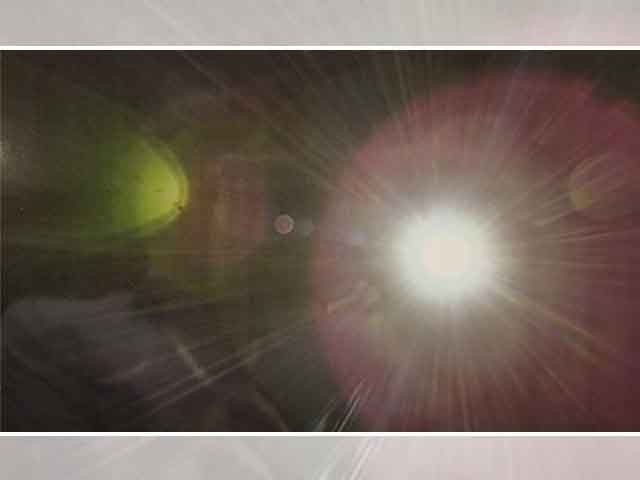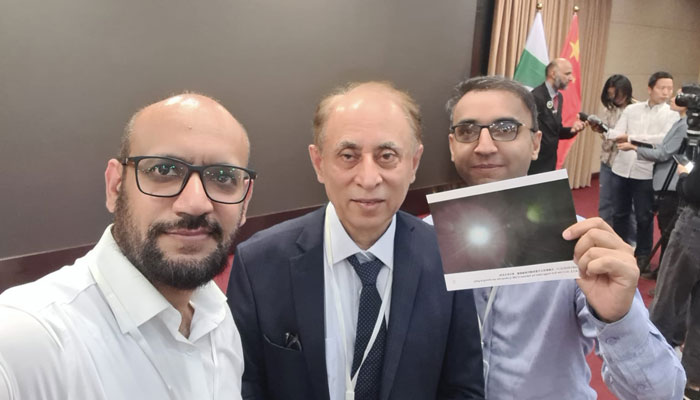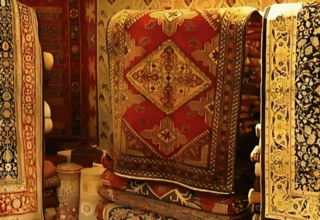Signals of iCube-Qamar will be received on Earth by covering a distance of 360,000 to 400,000 km, says IST
Pakistan’s orbiter ICUBE-Q beamed back on Friday the first image from the lunar orbit, marking a significant milestone in the country’s space programme.
A special ceremony on the successful mission was held at China National Space Administration, during which the Chinese authorities formally presented the first image to Pakistani Ambassador Khalil Hashmi.
The satellite is now in its fixed lunar orbit and is operating within specific parameters.
Experts had previously indicated that it may take approximately one week to verify the subsystems before the satellite imaging system becomes operational, after which the first image of the Moon is likely to be received by May 15 or 16.
The Chang’e 6 mission has entered lunar orbit under the influence of lunar gravity. In the next phase, the Chang’e 6 mission will deploy its lander and ascender to the far side of the lunar south pole.
On June 1, the main lander will detach from the spacecraft followed by Chang’e-6 mission to commence the collection of soil and rock samples from the lunar surface on June 2.
The Chang’e 6 mission is scheduled to commence its return journey on June 4. The mission will dock on June 6, and return to Earth on June 25 upon completion of its 53-day mission as per the program.
Pakistan’s space programme achieved a historic milestone on May 3 as the country’s first-ever lunar orbiter lifted off from China’s Henan Space Launch Site.
The quest to send a lunar orbiter started in 2022 when the China National Space Agency (CNSA), through the Asia Pacific Space Cooperation Organization (APSCO), offered member states an opportunity to send a student-built payload to Earth’s closest celestial neighbour onboard the Chang’e 6 mission.
The ICUBE-Q was submitted as a proposal for a lunar CubeSat by the IST. The proposal was selected after an evaluation process. The development of the payload was a collaborative effort between IST’s students and faculty, SUPARCO and China’s Shanghai Jiao Tong University (SJTU).
The payload consists of three parts, the CubeSat, the separation mechanism, and the mounting bracket. The payload itself weighs around 7kgs. It carries two cameras to take images of the lunar surface and has other sensors and apparatuses for deep-space communication, altitude controls, and other functions.
morover,
It added that the signals of iCube-Qamar will be received on Earth by covering a distance of 360,000 to 400,000 km.
“iCube-Qamar has made three rounds around the moon,” the IST said.
The first image was received two days after IST announced that the satellite was successfully deployed in orbit on May 8 at 1:14pm Pakistan time.
The scientist termed the development “a great success overall”.
Following its deployment, the satellite will take images of the desired lunar surfaces in a carefully selected 12-hour elliptical orbit.
The iCube-Qamar was launched on board China’s Chang’e-6 from Hainan, China, on May 3.
Ahead of the launch of the satellite last week, Dr Khurram said that the Pakistani satellite will take different pictures of the surface of the moon after which Pakistan will have its own satellite images of the moon for research.
The satellite was designed and developed by the Islamabad-based Institute of Space Technology (IST) in collaboration with China’s Shanghai Jiao Tong University (SJTU) and Pakistan’s national space agency Suparco.
iCube-Qamar orbiter carries two optical cameras to image the lunar surface. Following successful qualification and testing, the orbiter was integrated with China’s Chang’e6 mission — the sixth in a series of lunar exploration missions.




























